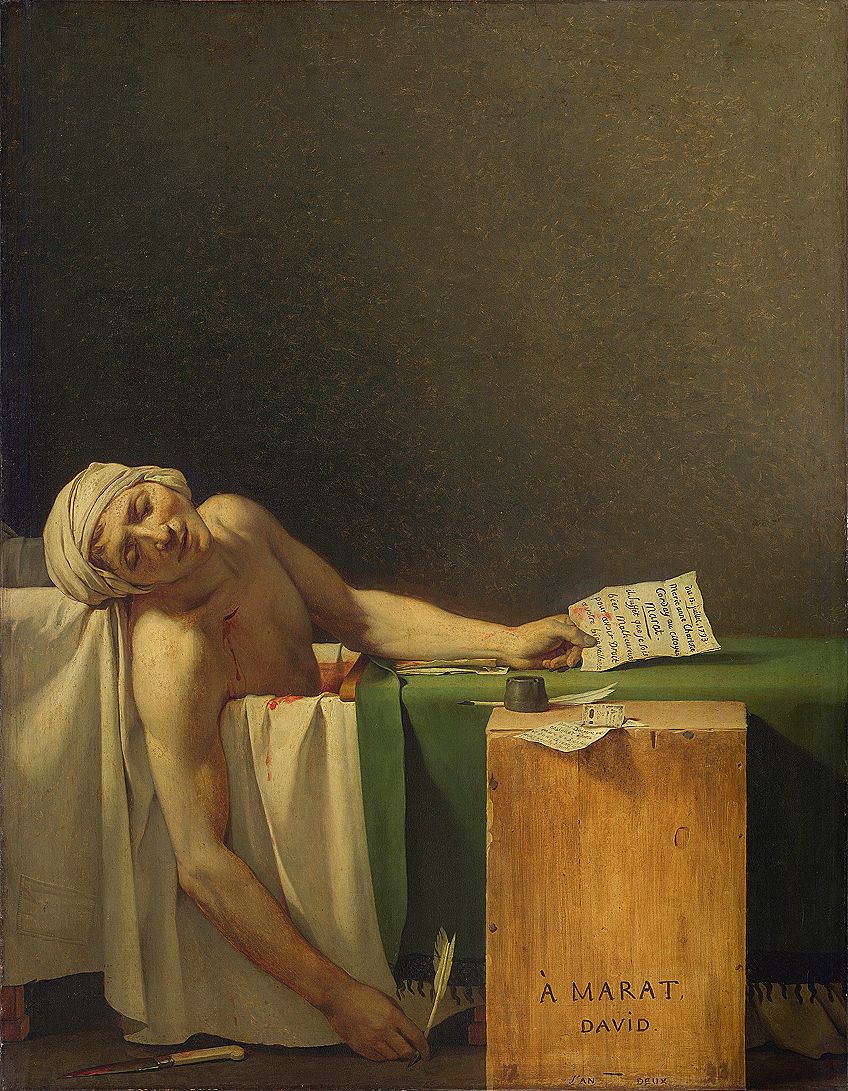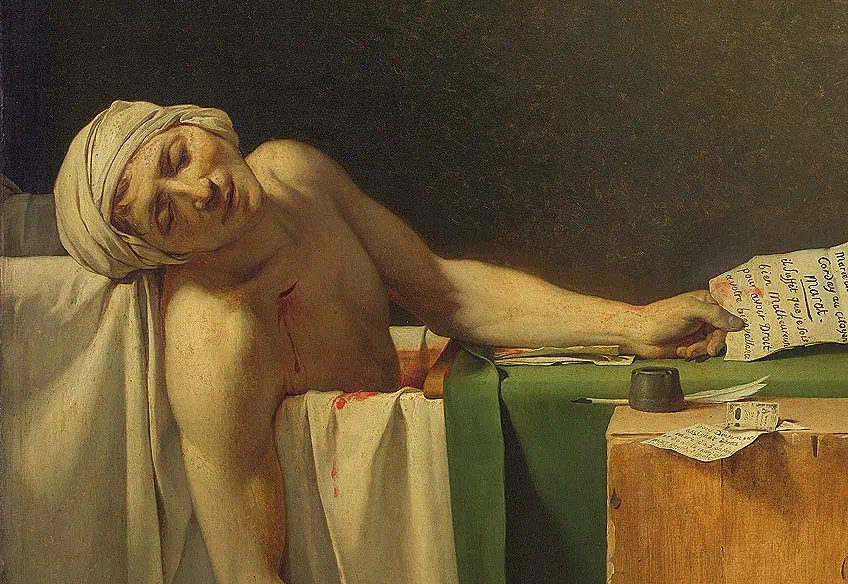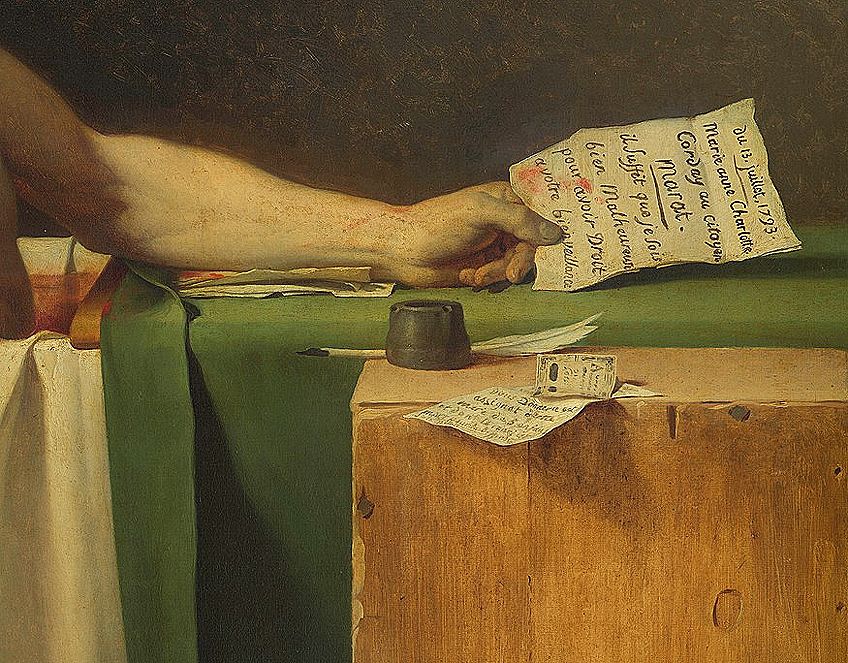“The Death of Marat” by Jacques-Louis David – An Analysis
The Death of Marat by Jacques-Louis David is one the most recognizable images from the era of the French Revolution. The Death of Marat, like most of David’s art from this decade, is a highly political piece that addresses an important event of that time – the assassination of Jean-Paul Marat, not only a personal friend of the artist but also an individual who played a pivotal role in the French Revolution. Join us as we find out more about the context of this famous artwork through an in-depth The Death of Marat analysis.
Contents
The Importance of The Death of Marat by Jacques-Louis David
| Artist | Jacques-Louis David (1748 – 1825) |
| Date Completed | 1793 |
| Medium | Oil on canvas |
| Dimensions (cm) | 162 x 128 |
| Location | Royal Museums of Fine Arts of Belgium, Brussels, Belgium |
Concerned with the disparity between the royal family’s wealth and that of France’s underpaid and highly-taxed populace, the people revolted against the monarchy’s rule and wanted reform. The Enlightenment, an 18th-century academic movement that promoted individuality, also had a significant influence on revolutionary views. Philosophers, authors, and other intellectuals came to Paris during this period to debate, write about, and share their views in the form of books, pamphlets, and newspapers. Following the Enlightenment, advocates of the French Revolution embraced and modified several aspects of the cause, particularly the use of media to convey their beliefs.

Jean-Paul Marat, previously a scientist and doctor, became a journalist after leaving his occupation. In 1789, he launched the publication The People’s Friend to attack the cause’s opponents, including other revolutionaries. Politically, Marat’s ideas were similar to those of the Jacobins, one of the most extreme groups to emerge from the Revolution. He eventually rose to become the leader of this party, which placed him in conflict with the Girondins, a different revolutionary faction Marat repeatedly condemned from his prominent position. His journalism was known for its ferocious tone and hard-line attitude on most major topics of the day, such as pushing for human rights for the destitute and being extremely critical of politicians and institutions. He was unquestionably one of the most radical voices of the French Revolution in the final moments of his life.
As predicted, Marat’s outspoken criticism of a number of France’s most influential people and organizations made him a significant target for his opponents. He nearly evaded capture in 1790; he was driven into hiding multiple times during 1792; and, eventually, he was murdered in his own house in 1793.
The Murder of Marat
Marat was writing in his bathtub on the 13th of July, 1793. As the pain of a persistent skin disease often restricted him to the bath, his tub had been equipped with a wooden board and acted as a temporary desk. His wife notified him that he had a guest called Charlotte Corday while he was working. Corday stated that she had classified information about a gang of the opposing Girondins, which aroused Marat’s curiosity. Against his wife’s suggestion that he not let her enter, he encouraged the visitor to sit next to his bath so he was able to write down the identities of this group. Corday, secretly a Girondin sympathizer, suddenly produced a knife from her dress towards the end of their conversation. She immediately thrust it into Marat’s heart before hiding in his house, where she was later discovered and imprisoned. Marat called out for his wife, but there was nothing she was able to do; he died within a minute or two.

The Death of Marat Analysis
Jacques-Louis David was assigned two tasks as a fellow Jacobin as well as a close friend of the deceased: arrange his burial and paint his death scene. Because Jacques-Louis David was a Neoclassical painter, one would usually expect something that referenced ancient antiquity or the Romans. With The Death of Marat, though, he went in a completely new direction. In essence, it is the depiction of a contemporary subject in the context of the era in which it happened.
Jacques Louis-David stated that he did this to accurately demonstrate the condition in which Marat had been found.
The painting portrays Marat minutes after his assassination, slumping over his blood-soaked tub, the quill he had been writing with still in hand. He did, however, take certain liberties in his representation, and hence the picture wasn’t meant to be a precise photographic replication of what took place. Marat, for instance, died with the knife stuck in his chest when he was killed. The knife can be seen on the floor in the artwork, though, and there is no blood coming from Marat’s wounds. Marat is depicted as a traditional hero, who passed away while writing in defense of the welfare of others. David finished the piece in his trademark Neoclassical style.

This painting, like other Neoclassical works by David, has a finely balanced composition; Marat and his tub create a horizontal plane in the foreground, which complements the composition’s minimalist background. This arrangement ultimately results in a stage-like scenario in which a physical spotlight highlights the main actor and a number of strategically placed items, notably his freshly-written list and the blood-stained knife on the floor. An emerging interest in Classical idealism is another Neoclassical feature present in The Death of Marat by Jacques-Louis David. While the style and majority of the features of the bathtub arrangement are accurate, David chose to romanticize Marat by sacrificing a realistic representation of his obvious dermatitis in exchange for the appearance of blemish-free skin. This intentional move, together with Marat’s Pietà-like posture, portrays Marat as an immaculate martyr.
The Death of Marat by Jacques-Louis David is extremely symbolic, with the sole purpose of portraying the person as an innocent victim and hero. Absolutely nothing was painted for the sake of adornment. Each aspect, even down to the identity of the killer on the piece of paper he is clutching, has a purpose. It was extremely popular among revolutionaries, with multiple copies created as propaganda by David’s students. The artwork, however, went out of favor after the Revolution and was concealed someplace in France for a number of years. It rose from obscurity in the mid-19th century and found a permanent home in the Royal Museum of Fine Arts’ collection in Brussels, where it has resided ever since.
Frequently Asked Questions
Who Was Marat from the Famous Painting by Jacques-Louis David?
Jean-Paul Marat was a physician and political thinker who rose to prominence during the French Revolution, notably during the Reign of Terror. He was a fervent follower of the revolution’s ideas and an outspoken advocate for the rights of the lower classes. Marat used his journal to espouse his radical viewpoints and to urge direct action against suspected adversaries of the revolution. He was a key figure in the planning of the September Massacres of 1792, in which crowds murdered imprisoned counter-revolutionaries.
How Did Marat Die?
Charlotte Corday, a Girondin sympathizer, killed Marat in his bathtub. She arrived at his home one day and asked to speak to him, pretending that she was there to give him a list of suspected adversaries. After he had written down the list of names, she took out a knife and plunged it into his chest. He tried calling out to his wife, but died a few moments later.
Jordan Anthony is a Cape Town-based film photographer, curator, and arts writer. She holds a Bachelor of Art in Fine Arts from the University of the Witwatersrand, Johannesburg, where she explored themes like healing, identity, dreams, and intuitive creation in her Contemporary art practice. Jordan has collaborated with various local art institutions, including the KZNSA Gallery in Durban, the Turbine Art Fair, and the Wits Art Museum. Her photography focuses on abstract color manipulations, portraiture, candid shots, and urban landscapes. She’s intrigued by philosophy, memory, and esotericism, drawing inspiration from Surrealism, Fluxus, and ancient civilizations, as well as childhood influences and found objects. Jordan is working for artfilemagazine since 2022 and writes blog posts about art history and photography.
Learn more about Jordan Anthony and about us.
Cite this Article
Jordan, Anthony, ““The Death of Marat” by Jacques-Louis David – An Analysis.” artfilemagazine – Your Online Art Source. June 14, 2023. URL: https://artfilemagazine.com/the-death-of-marat-by-jacques-louis-david/
Anthony, J. (2023, 14 June). “The Death of Marat” by Jacques-Louis David – An Analysis. artfilemagazine – Your Online Art Source. https://artfilemagazine.com/the-death-of-marat-by-jacques-louis-david/
Anthony, Jordan. ““The Death of Marat” by Jacques-Louis David – An Analysis.” artfilemagazine – Your Online Art Source, June 14, 2023. https://artfilemagazine.com/the-death-of-marat-by-jacques-louis-david/.



